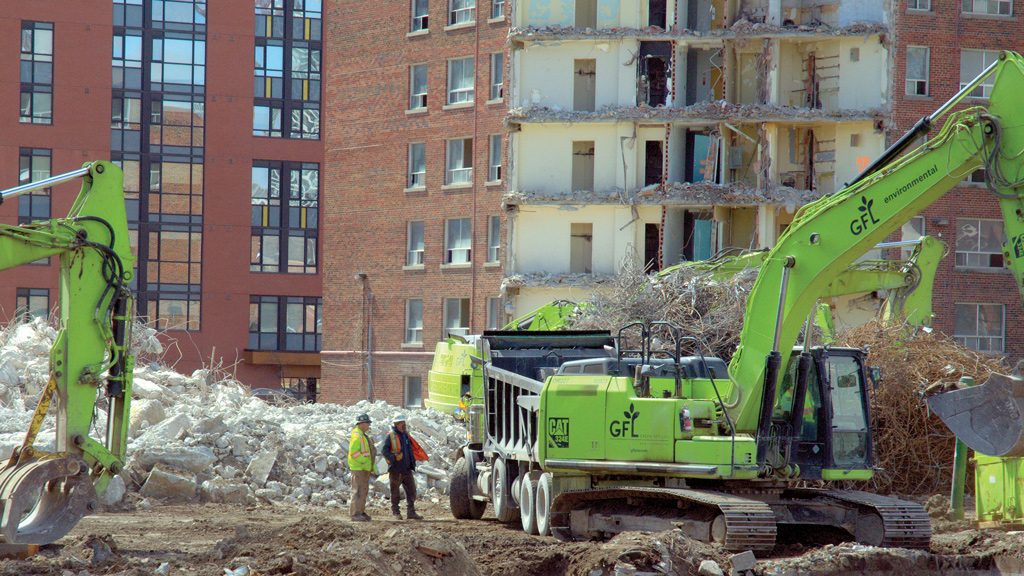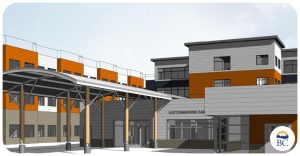Dump trucks rumble in and out of the demolition site while a block away, cement trucks rumble onto an adjoining site along with more trucks loaded with construction materials.
This isn’t business as usual on a Toronto job site where demolition and construction are proceeding side-by-side and have been for 13 years. In the middle of this orchestrated chaos there’s an entire community and assorted businesses and two schools trying to make the best of things in a 12-block construction zone sprawling across 69 acres in downtown Toronto.
The Regent Park revitalization project has been underway since 2006 and seeks to replace the 1940s public housing project with a new, broader mix of housing to serve more people, both on social assistance and those who can afford to buy.
Phase three demolition is well underway at the northwest corner of Regent Park at Parliament Street and Gerrard Street East. Phases four and five are yet to start. Phase one construction is complete and phase two is well underway.
Demolition in this case, however, isn’t just a matter of rolling the heavy machinery onto the site and tearing down the low and mid-rise brown-brick buildings and then trucking the debris away.
The Daniels Corp. has partnered with Toronto Community Housing Corp. (TCHC) to redevelop Regent Park.
Kelly Skeith, the TCHC’s senior development director says that given the scope of the revitalization, there’s no way to avoid disruption, only to minimize the impact on residents and businesses. However, she says, with the new buildings, parks and other amenities from the initial phases in place the transformation is proving itself as a worthy goal.
“It’s not even those who were here when it started, we’ve got people who have moved into the new buildings and see this still all going on,” she says. “Phase three is 20 acres and 10 city blocks, plus a hockey rink and its all downtown so it is disrupting.”
She says maintaining communications has been critical with regular meetings, a website and posters advising people as to what is happening and what closures and specific changes are coming up.
The Regent Park Neighbourhood Association (RPNA) and a special community construction liaison committee also work closely with the TCHC, Daniels Corp. and demolition contractor GFL to flag and resolve issues as they crop up.
“It’s also fluid because as the construction or demolition moves around, it involves different people and businesses next to that site,” Skeith says.
It’s a nightmare of logistics for builder/developer Daniels Corp. and GFL who have worked closely with the TCHC, residents, businesses, schools, the Toronto Transit Commission and police to be as clear and transparent as possible about what is happening while also being responsive to issues around noise, dust and, of course, traffic.
By the time the last building is occupied, sometime in the mid-2020s, the revitalization will see 2,000 rent-geared-to-income (RGI) units, 700 new affordable housing units and 3,000 market-price condominium units. It will be a mix of townhouses, mid-to-highrise apartment buildings and retail.
What was once a no-go zone where roads were blocked and where drug dealers and gangs ruled, reconnected streets and community centres in park settings will be pedestrian and vehicle friendly.
And what was once home to 7,500 residents in north and south Regent Park living in 2,083 units, there will be more than 12,500 residents in a mixed-income and mixed-use community.
“In some ways it is a bit of a ballet,” says Megann Willson who represents “market” condo residents on the RPNA. “It might be we’ve been living with this for so long that as my dad used to say, we’ve done so much with so little for so long we can now do anything with nothing.”
It’s no easy job when there are so many physical constraints, social and community concerns and logistics involved.
“It really has been a challenge,” says Remo Agostino, Daniels Corp’s. vice-president of development. “And it’s something we have to pay close attention to since we started phase one back in 2006.
“That was 10 acres but consistently in one corner and contained. There’s been a lot of learning since then. You have to be absolutely dynamic and responsive — and available to respond and do something when there’s an issue.”
While the demolition runs 10 hours a day, GFL has to be sensitive to local residents and contain the noise, not to mention the trucks. Those dump trucks must not run past either of the two schools during pick up and drop off times. Scheduling of a tower demolition on a site adjacent to a school had to be done during March break.
“The contractor went in and stripped the 13-storey building from the inside,” says Agostino.
“Clearly it was next to a school yard and while the kids aren’t outside as much in the playground in winter, we didn’t want to be taking down the tower with all the dust and the kids so close. They (GFL) managed to do it during March break when the kids were out of school.”
Mitigating dust is always an issue for these kinds of projects, he adds.
“You spray water in the dry season, the summer, but you can’t spray in winter because it just freezes up,” he says.
The end result is having to constantly juggle issues on a daily basis, he adds.
“It’s a balancing act in that there’s no one solution for every issue,” he says.
“We’ve established a good rapport with the community and we’re all working to stay on top of it.”






Recent Comments
comments for this post are closed